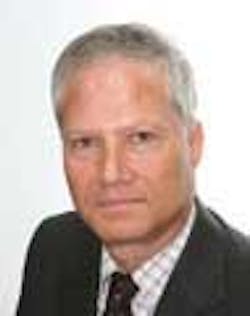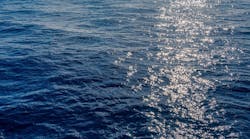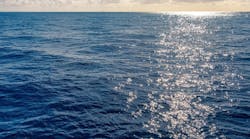The crane bargeSaipem 7000 has installed the first components for the subsea compression station serving Statoil's Åsgard complex in the Norwegian Sea. These comprised the 1,800-metric ton (1,984-ton) subsea template that will contain the compressors and the module providing power for the new subsea system, to be installed on the Åsgard A production ship 43 km (27 mi) away. Water depth at the site is 300 m (984 ft). The 22 modules forming the compressor trains will be installed next year.
Assuming Statoil achieves its goal of verifying the compressor technology, the facility should be ready to start operating on Åsgard in 2015. Over time, the company expects the $2.9-billion project, which will compress up to 21 MMcm/d of gas, to increase recovery from the Midgard and Mikkel reservoirs within the Åsgard area by 280 MMboe.
In the North Sea, the company has commissioned what it claims is the world's first well stimulation tanker, designed to boost oil extraction from the producing Snorre field.Siri Knutsen, a former shuttle tanker, was converted for the role and now features a new mezzanine deck housing three fresh water modules, five pumps, a control system, and a larger accommodation area.
Fresh water and sodium silicate will be injected into Snorre's E-4H water injector well as a test case to increase oil output from the P-15 production well. Previously on Snorre, Statoil has pumped water into the porous sandstone rock to press out oil; however, sandstone quality varies in different parts of the reservoir, leaving large volumes unswept. Sodium silicate is affected by the reservoir temperature, taking on a gel-like consistency that blocks the pores in the reservoir where water flows most easily, forcing the water to find new routes.
With the new injector well, hydrochloric acid will be added to the water mix to adjust the PH level. The company, which has been working on the new technique since 2008, says the planned pilot wells are in a relatively isolated segment of the reservoir. Halliburton and Knutsen are supplying the equipment and the vessel, at a total estimated cost of $62.5 million.
Developments off Iceland
The Faroese government has awarded Danish company DONG Energy two licenses covering six offshore blocks in the Faroe-Shetland basin, under the islands' Open Door license round. DONG's blocks extend over 900 sq km (347 sq mi), and are west of the developed Foinaven and Schiehallion fields, and the undeveloped Tornado. They also include Marjun, the sole publicized Faroese offshore oil discovery to date. DONG plans to apply new 3D seismic data and in-house processing techniques to progress prospects.
To the north, Iceland's National Energy Authority Orkustofnun is reviewing local company Eykon Energy's application for the country's second licensing round in the offshore Dreki area. The company submitted its original bid last year, on the understanding that it would need to bring in a bigger partner to manage its planned exploration program. In June China's CNOOC stepped into the breach - Orksustofnun is now reviewing the partnership's financial and technical capacity to carry out the work, and will make its decision on awarding the license this fall. Norway has the right to back into 25% of any concession Iceland awards in this offshore region, which is between the two countries.
Breagh re-think
First gas was due to flow this month from Breagh, one of the larger field developments in the UK southern North Sea in recent years. Operator RWE Dea and partner Sterling Resources are now turning their attention to Breagh Phase 2, focused on the eastern side of the field.
The project has been running behind schedule due to a combination of weather delays and commissioning issues at the terminal in Teesside, northeast England, that will receive the field's gas. As a result, according to field analysts BritBoss, capex is far beyond the $649 million budgeted. On the plus side, the performance of the first three production wells drilled suggests reserves may be higher than previously thought, causing the partners to revise their Phase 2 plan.
Sterling said well A03 appeared to penetrate a Carboniferous section with better porosity and higher permeability. The same applied to the subsequent A05 well - once drilling here is completed, the geological model for the north/northeastern parts of the 80-sq km (31-sq mi) field will be refined and the new well data will be used for Phase 2 adjustments.
Phase 1 is based around an unmanned 5,400-ton platform on the western part of the field built by Heerema Vlissingen in the Netherlands. The gas will be exported to Teesside via a 100-km (62-mi), 20-in. subsea pipeline with a 9-km (5.6-mi) onshore section.
In the UK central North Sea, Antrim Energy is making a fresh attempt to develop the small heavy-oil Fyne field, discovered by Mobil in 1986. Antrim had planned to use Teekay's circular Sevan FPSOHummingbird Spirit as the central production system, with three subsea drill centers. But a poor result from the East Fyne appraisal well last year caused partners Premier and First Oil to exit the license.
Now Enegi Oil and partner Advanced Buoy Technology (ABT) have agreed to perform fresh engineering studies based around ABT's marginal field production buoy concept with oil offloaded to a tanker. If they can make the economics work - and Britain's government approves their entry into the license on a 50-50 basis with Antrim - this could be the North Sea's first unmanned buoy development, although Energi/ABT have other application options elsewhere in the UK sector.
UK attractions remain strong
Wood Mackenzie forecasts £44 billion ($66.5 billion) of development capex across the UK continental shelf over the next five years. The analysts, marking 40 years of reporting on the sector, add that currently 126 companies hold interests licenses offshore the UK. Although this is way below the 292 present in the sector in 1973, it is still the highest total in any European country.
Another big change since those early days of UK North Sea production is that today, more than 60% of the sector's commercial value and three-quarters of operatorships are held by companies that are not majors. And following CNOOC and Sinopec's deals with Nexen and Talisman last year, Chinese companies will produce around 10% of UK liquids during 2013-2017, the analysts claim.
Since the first UK offshore fields were developed, nearly £300 billion ($453.5 billion) in 2013 terms has been invested in upstream development, they add. During 2012 UKCS development spending reached £11 billion ($17 billion), similar to levels in real terms last seen in the mid-1970s. Although this can partly be attributed to cost inflation and the higher costs needed to develop more challenging reserves, it suggests that the sector remains vibrant. And despite its maturity, the country still ranks as a Top 10 destination for investment globally.







